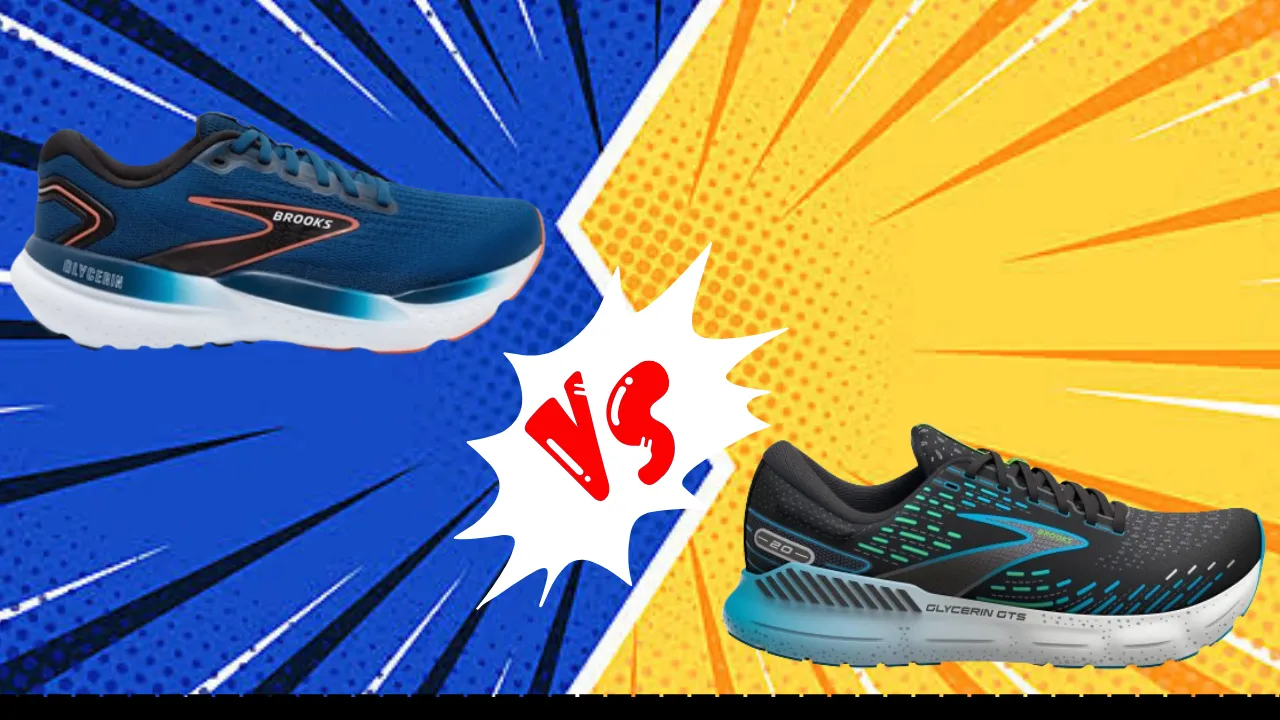If you’re a runner looking for a dependable, well-cushioned shoe, the Brooks Glycerin 21 and Glycerin GTS 20 are two great options to consider. Both shoes provide a plush, comfortable ride but have some key differences when it comes to stability, weight, and ideal usage. This in-depth comparison breaks down the specs, features, and performance of each shoe to help you decide which is better for your needs.
Similarities And Differences Between Brooks Glycerin 21 and Glycerin GTS 20:
| Category | Glycerin 21 | Glycerin GTS 20 |
|---|---|---|
| Launched In | 2024 | 2022 |
| Stability | Supportive and stable | Very stable |
| Flexibility | Moderately flexible | Medium flexibility |
| Sizing | Men’s 7-13, 14, 15, 17; Women’s 5-12 | Standard sizing |
| Weight | 9.30-10.50 oz | 10.5 oz (men’s), 9.4 oz (women’s) |
| Cushion | Plush and comfortable | Highly cushioned |
| Outsole | Durable rubber | Carbon rubber |
| Midsole | DNA Loft | DNA LOFT v3 |
| Upper | Engineered mesh | Breathable mesh |
| Retail Price | $160 | $160 |
Features Comparison:
Materials:
The Glycerin 21 features an engineered mesh upper which provides a flexible, breathable fit. The DNA Loft midsole uses nitrogen infusion to deliver soft, responsive cushioning. On the outsole, durable rubber provides traction and longevity.


The Glycerin GTS 20 has a more traditional construction with a breathable mesh upper, DNA LOFT v3 nitrogen-infused midsole, and carbon rubber outsole.
Both shoes use high-quality materials but the Glycerin 21 incorporates newer engineered mesh for a slightly more dynamic fit. The carbon rubber outsole of the GTS 20 may have marginally better durability than the standard rubber of the Glycerin 21.
Durability:
The outsoles are a key factor when considering durability. The carbon rubber on the GTS 20 provides excellent traction and is likely to be slightly more durable than the standard rubber compound used on the Glycerin 21.
However, both shoes use quality materials that are designed to last for many miles. The Glycerin 21’s engineered mesh upper may lose some structural integrity over time compared to the traditional mesh of the GTS 20.
Overall, both shoes should provide an above-average lifespan for high-mileage neutral trainers. The Glycerin GTS 20 may have a slight edge in outsole durability while the Glycerin 21 counters with a newer midsole foam. For most runners’ purposes, durability will be comparable between the two models.
Fit:
The Glycerin 21 features an engineered mesh upper that provides a flexible, dynamic fit that adapts to the foot during runs. It has a wider fit through the midfoot and forefoot to accommodate swelling feet later in runs or wider foot profiles.


Meanwhile, the Glycerin GTS 20 has a more traditional upper fit with less stretch and structure from overlays. The GTS 20 offers a secure midfoot wrap and heel counter for stability but has less room for swelling feet. Underfoot, both models use DNA Loft midsoles that compress and conform to the individual foot shape.
The Glycerin 21 will likely fit a wider range of foot shapes thanks to its engineered mesh upper but the GTS 20 provides a locked-in fit for average foot widths. Trying both models is recommended to determine the best fit and comfort.
Stability:
The Glycerin GTS 20 is designed as a stability shoe with guide rails built into the midsole to prevent excess pronation. It has a substantial heel counter and firm midfoot chassis for optimal rearfoot control. Runners who need mild-to-moderate pronation correction will benefit most from the GTS 20.
On the other hand, the Glycerin 21 is a neutral cushioned trainer without targeted pronation-control features. However, it does provide a stable platform from heel to toe to keep the foot moving straight.
If you are an overpronator who requires stability technology, the GTS 20 is the better choice. For neutral runners or those with mild overpronation, the Glycerin 21 gives a stable yet flexible ride. The extra midsole cushioning also contributes to a smooth, stable stride.
Cushioning:
With maximum cushioning as the goal, the Glycerin series is known for its plush, comfortable rides. The Glycerin 21 features DNA Loft cushioning that delivers soft landings without feeling mushy or bottomed out. It gives a responsive, pillow-like sensation underfoot.
The Glycerin GTS 20 also utilizes DNA Loft foam but splits it into two sections which work together to provide cushioning and support. Testers found the GTS 20 to be highly cushioned yet reactive. Overall, the Glycerin 21 likely has a slight advantage in delivering an ultra-plush ride.
However, both models effectively absorb impact while providing energy return on toe-off. Neutral runners and heavy-footed strikers will benefit most from the extra cushioning quantity of the Glycerin 21 while the GTS 20 gives a balanced, supported sensation.
Value:
With an MSRP of $160, the Glycerin models are premium-priced daily trainers. The prices are justified by high-quality, durable materials and generous cushioning.
When comparing the two, the Glycerin 21 has a slight edge in value since it includes newly engineered mesh, the latest DNA Loft cushioning, and a smoother overall ride.
However, the Glycerin GTS 20 still delivers excellent performance for overpronators. If you specifically need stability, it remains a top option even though a generation behind the 21. Neutral runners get more features for the money with the Glycerin 21.
In summary, both deliver great value but the Glycerin 21 gets a small boost for its versatile comfort and newer midsole foam. Sales prices around $120 make both models strong values for high-mileage training and long-distance racing.
Performance Comparision:
Walking:
For walking shoes, cushioning and fit are top priorities because comfort lasts all day. The Glycerin 21 excels as a walking shoe thanks to its plush midsole, flexible upper, and roomy toe box design.
The DNA Loft foam absorbs shock while allowing natural foot motion. The engineered mesh upper dynamically adapts to swelling feet and wider foot shapes often found in walking shoes.
While the GTS 20 is also well-cushioned, its snugger fit may cause discomfort over long periods of walking. It also lacks the flexible adaptability of the Glycerin 21’s mesh upper. For walking comfort right out of the box, the Glycerin 21 is the better choice.
Running:
During runs, the Glycerin 21 provides an ultra-soft, bouncy sensation that excels at high mileage. The DNA Loft foam protects legs on long runs while having enough response for tempo days. The smooth transition encourages a natural gait at various paces.
As a stability option, the Glycerin GTS 20 gives firm guidance against overpronation during runs. Testers noted its supportive ride works well for heavy runners who need pronation control. The GTS 20 has a slightly firmer ride but still delivers a cushioned, balanced sensation.
For neutral runners or those needing minimal stability, the Glycerin 21 is the winner. However moderate to severe overpronators are better served by the motion-control properties of the Glycerin GTS 20. Both absorb shock effectively but cater to different running needs.
Plantar Fasciitis:
The generous cushioning of both models helps absorb shock to reduce pain from plantar fasciitis. However, the Glycerin 21 has the advantage of PF relief with its DNA Loft foam providing a plusher landing zone. The engineered mesh upper also adapts to accommodate orthotics or splints.
Reviewers particularly praise the heel cushioning of the Glycerin 21, noting it substantially minimizes heel discomfort. In contrast, the firmer DNA Loft foam of the GTS 20 isn’t quite as effective at shock absorption, especially for heel strikers.
Its structured upper resists changes to accommodate medical devices. While the GTS 20 can alleviate some PF pain, the Glycerin 21 is better equipped with its ultra-soft midsole and flexible upper. For plantar fasciitis and heel discomfort, the Glycerin 21 is the top choice.
Standing All Day:
Cushioning and comfort are vital for standing all day, making the Glycerin 21 the top pick. The plush DNA Loft midsole avoids foot fatigue and pain even during long periods on your feet.
Reviewers praise the soft yet responsive cushioning that seems to adapt to the foot’s needs after hours of standing. The roomy toe box leaves space to splay toes and redistribute weight off pressure points like the balls of the feet. The engineered mesh upper also has stretch to accommodate swelling feet.
While the GTS 20 uses the same DNA Loft foam, it has a firmer density that can pack out over time when standing for long periods. Its snugger midfoot fit also puts more pressure on the arches compared to the Glycerin 21. For the most durable cushioning and roomiest fit to stand comfortably all day, the Glycerin 21 is the superior option.
Final Verdict:
For neutral runners seeking a versatile daily trainer with maximum cushioning, the Brooks Glycerin 21 is a clear choice. Its plush midsole, smooth ride, and comfortable engineered mesh upper make it a great option for high mileage training, race day, recovery runs, and walking.
Overpronators who require stability technology are better served by the Glycerin GTS 20. It delivers firm guidance against excess pronation thanks to its structured midsole and upper.
Both models provide excellent shock absorption, making them suitable for runners with plantar fasciitis or heel pain. However, the plusher cushioning of the Glycerin 21 gives it an advantage for pain relief. Standing all day is also more comfortable in the Glycerin 21 due to its DNA Loft cushioning and roomy toe box.
While the Glycerin GTS 20 is a stability standout, the Glycerin 21 claims the title of the ultimate neutral cushioned trainer. Trying on each model is recommended to determine which feels best for your individual foot shape and gait needs.

